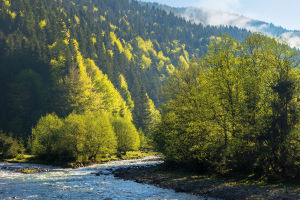Landforms are natural physical features that exist on the Earth's surface. They are shaped by a combination of various geological and environmental processes over millions of years.
These processes include tectonic movement, erosion, weathering, and deposition, among others. Landforms can be classified into five basic types: plains, plateaus, hills, mountains, and basins.
Plain terrain is a vast area with low and flat terrain, usually within 200 meters above sea level. It is commonly found in the middle and lower reaches of rivers and coastal areas.
The largest plain in the world is the Amazon Plain in South America, covering a total area of 5.6 million square kilometers. The Amazon Plain contains the world's largest tropical rainforest belt, which is an important ecosystem for the planet.
The Danxia landform is a unique rock formation consisting of square mountains, strange peaks, cliffs, caves, and stone pillars. These formations are made up of thick red sandstone and conglomerate and are mainly developed during the Jurassic to Tertiary periods.
They are produced in horizontal or gently inclined red terrestrial strata. The development of Danxia landforms began with the Himalayan movement in the late Tertiary period, which deformed part of the red strata and lifted the basin.
The red strata were then eroded by water, gravity, and wind along the vertical joints, forming deep ravines, remnant peaks, stone walls, stone pillars, crumbling cones, as well as stone buds, caves, funnels, stalactites, and other geomorphic forms.
The Danxia landform is a unique and beautiful natural wonder that attracts many visitors and tourists every year.
The Karst landform is another fascinating type of landform created by the dissolution of soluble rocks by water with dissolution force. This process is collectively known as karst action and mainly occurs through dissolution but also includes mechanical erosion processes like water erosion, subduction, and slumping.
The resulting surface and subsurface formations are called Karst landforms.
The name Karst originated from the carbonate plateau of the Istrian Peninsula in northwestern Yugoslavia, where modern Karst research began. Karst landforms are known for their distinctive features, such as sinkholes, underground rivers, caves, and limestone towers.
These features make Karst landforms unique and visually appealing, drawing many tourists to them every year.
Coastal geomorphology is the study of the various landforms formed by the combined effects of tectonic movements, seawater dynamics, biological effects, and climatic factors on the coast.
The Quaternary period, which saw a significant rise and fall of sea level and sea advance and retreat, resulted in a constantly changing coastline.
Between 6,000 and 7,000 years ago, the sea level rose to the modern sea level height, forming the basic outline of the modern coast and various coastal landforms. Examples of coastal landforms include sea cliffs, beaches, spits, and barrier islands.
Submarine geomorphology is the study of the solid surface formations of the Earth covered by seawater. The seafloor is made up of towering seamounts, undulating hills, rolling ridges, deep trenches, and flat plains of the deep ocean.
The mid-ocean ridge, which runs through the middle of the ocean, stretches 80,000 km and is hundreds to thousands of kilometers wide, with a total area comparable to that of the global landmass.
The deepest point of the ocean, the Mariana Trench in the Pacific Ocean, is located 11,034 meters below sea level, exceeding the altitude of Mount Everest, the highest mountain on land, which is 8,846.27 meters.


